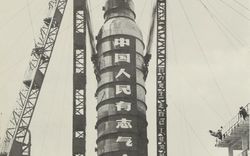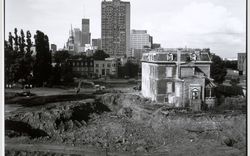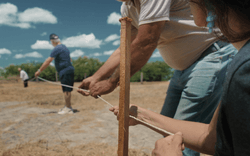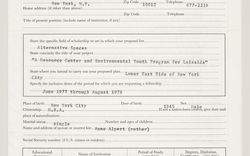Things to Be Done
Sony Devabhaktuni writes to Merve Bedir
Merve, I am writing prompted by the question of architecture’s political agenda. Does it have one? Should it have one? In my mind, trying to answer these questions by asking what a “political” architecture “looks like” or could be leads astray because it assigns to architecture an agency that reduces its politics and political agenda to the productivity of its objects. This, for me, is unsatisfactory as it directs away from an interrogation of practice.
The question of a political practice has been on my mind since leaving Hong Kong for the suburbs of Philadelphia a little more than two years ago. In both places, as in so many others now, political agonisms have been met with authoritarian measures to arrest what is legitimate and necessary in contestation. And here, I follow Chantal Mouffe’s proposition that the political is a latent negativity domesticated by the institutions and interest groups of politics.1 The question then is about architecture’s agency within such a climate: how to do architecture politically.
In my time here, I have begun to focus on the communities of Delaware County where I live, and particularly in the city of Chester. In Chester, politics, for more than a half century, has flattened what is conflictual through machinations and sleights-of-hand enforced by inequities of power, hastening racialized expropriation.2 But in the past decade, organizing and localized efforts have again begun to assert and sustain a public home. With my students3 this past semester, it has been important to sit with residents of Chester to learn about these efforts, while at the same time beginning to survey sites where materiality resonates with the stories being shared.4
With this work in mind, I want to consider another way into the question of architecture’s politics: through “agenda,” pointing as it does toward practice. “Agenda” shares with “agency” and “action,” the Proto-Indo-European root “ag-” whose meaning is to “to drive, draw out or forth, move”. In Latin, agenda’s appearance becomes more generally associated with doing, while in English, the first use of “agenda” described “things to be done, viewed collectively; matters of practice, as distinguished from belief or theory.”5 This definition from the seventeenth and eighteenth century is a pair with the now obsolete credenda which describes things to be believed. Both “things to be done” and “things to be believed” are liturgical terms: prerequisites for entering heaven. “Matters of practice” in this now obsolete acceptation thus describes not belief put to action—the contemporary praxis of a politically oriented encounter with the world—but something more mundane. As matters, what is practiced are relations. Matters subtend the goings on of the day: they are “things to be done,” necessary for perduring—making it through—but also in the positive sense of accomplishments that unlock a possibility: things to be done (in order to enter heaven). That these things are “viewed collectively,” suggests that the question of what is to be done cannot be resolved in isolation.
Somehow, all of this resonates with my experience getting to know people in Chester. What seems relevant in discussions, are the places that motivate their efforts: for example, an abandoned African American cemetery that dates from 1907 and includes graves of Buffalo Soldiers who fought in the Civil War. With the death of the cemetery’s caretaker about 20 years ago, this burial ground has become overgrown with tall grass, thickets, and a copse of trees; many headstones have been toppled or subsumed with the ground’s freezing and thawing. In recent years, a group of volunteers has come together to organize weekly tending that has succeeded at holding back growth in about one third of the site.6 While a set of shared values binds this collective, it is, in my mind, an understanding of what is to be done that undergirds practice.
Here, agenda is a relational doing, in which those “things to be done” speak both pragmatically and positively toward what remains to be achieved. While the distinction between agenda and credenda is perhaps imbricated in the way that any determination of effort is informed by what is valued, the point is to shift attention from systems of belief, dogma, or principle to the doing. What is more, this shift of attention suggests that the political lies in an interrogation of the relations that intercede in the carrying out of what is to be done. For architecture, this means that the political cannot be bracketed within the productivity of the object but is implicit to the relations that comprise matters of practice.
What are these relations? Elizabeth Shove, in her work on energy consumption, considers “matters” as the “things” that make the quotidian possible. She proposes that there are at least three thing types: things in the background, things in action, and things that are used up: infrastructures, devices, and resources.7 For Shove, these categories are slippery, nested, and overlapping but nevertheless speak to the way that practices engage with the material world: with matter. It is our relations with these matters that situate practices.
Here, I would also include relations of the human and other-than-human kind: those interactions that in subtle and direct ways are also things that make practices possible. As such, they are equally an “infrastructure”: in the background, but also what Lauren Berlant terms a “lifeworld” that helps with a making it through.8 In Chester, this lifeworld of relations—with the built environment, between residents and with the non-human life that appears as an urban nature—comprises this infrastructure. As such, it binds and provisions for a making it through in a period of social and structural transformation; it makes it possible to hold on.
In my mind, matters of practice are distinct from Bruno Latour’s “matters of concern,” elaborated in response to the post-factual world brought into view by September 11 and climate denial.9 Latour sought to articulate a role for critique that could “gather” rather than refute: bring together matters of concern, rather than take apart matters of fact. Now more than 20 years later, the suspect position of facts no longer depends on their critical deconstruction but proceeds as a banality through all forms of media. Thinking through matters of concern instead allows for the careful articulation of the discourses, histories, usurpations, and occlusions that inform, situate, and are produced by and through objects and phenomenon. Latour acknowledged in his argument for “matters of concern” that the term gives another name to ideas floating in the air, one of which—the “mangle of practice”—includes a recognition of the role that practices play in articulating the reality of even the hardest of facts.10
Despite this overlap, in my mind, matters of practice is distinctly salient for the way it speaks directly to doing and the relations implicated in that agenda. This means, for example, that how relations are acknowledged, cared for, and sustained are primary to architecture’s political capacity. What this means, as well, is that critique’s expansion in recent decades to consider matters of concern—from labour, to extraction, the other-than-human, decolonization, social justice, and issues around maintenance and care, for example—should vigorously inform the relations that comprise matters of practice. Here, what I want to say is perhaps not far from Max Liboiron’s framing of anti-colonial science as informed by “good relations” that reject the technologies of settler colonialism.11 Liboiron’s assertion is that rather than remaining within a realm of external history or ideology, it is the methods of day-to-day science that need to be interrogated for their own relation to these technologies and to Land. Such a reorientation for me comprises a shift from matters of concern to matters of practice. It is one that speaks to what it would mean to do architecture politically.
What then is an architecture of “good relations”? With Land, but also with other matter (infrastructures, tools, resources) and human, and non-human others: relations of labour, of extraction, of community; of work-hours, of material sourcing, of protocols of engagement? From Doreen Massey, I understand that being in relation begins with a recognition of difference and of the dynamics of power that characterize these differences.12 Relation also implicates a co-constitutive transformation enacted through any exchange. With power and change in mind, relations come with responsibilities and implicate negotiations that manifest as a continuous attention. Here, we circle back to Mouffe and the agonistic contestation that necessarily underlies the political. Massey situates this negativity not as an unsurmountable challenge, but as the everyday of an encounter with difference. It is in relations with matters therefore that the political is practiced.
In Chester, it is possible that the time we spend and the work that is done will leave little trace: no projects or material interventions that are architecture’s normatively recognized productions. But perhaps that objective already closes off an orientation toward being in relation that can recast architecture’s primary responsibility. Indeed, there is a harm that arises from hopes raised and potentials left on the table. That recognition also needs to inform any effort and points even more clearly to what is political in the work.
Merve, I am looking forward your thoughts on any of this.
Thank you.
-
Chantal Mouffe, On the Political: Thinking in Action (Routledge, 2005). ↩
-
For a concise history of these dynamics, see: Christopher Mele, Race and the Politics of Deception: The Making of an American City (NYU Press, 2017). ↩
-
Nico Chang, Noah Kennel, James Lewis, Li Xinyun, Theo McGreevy, Jetsuen Pema, Ada Reddington, Chanduli Rubasinghe, Justine Sullivan, Imanie Walters. Isabel Llosa from Swarthmore College assisted with the class throughout the semester. ↩
-
Partners for work on the Green Lawn Cemetery: Roscoe Green, Bertha Jackmon, Jim Mosley, Sam Shavers, Naomi Richardson, and Twyla Simpkins; on Chester’s Overtown district and Avenue of the States: Arkmallah Hilliard, John Linder, Roland Taylor, Devon Walls, L Ward; and on the Deshong Park and Memorial Art Gallery: Van Buren Payne, Mary Payne, Jim Turner, Roland Wallace, Liz Williams, and Jill Borin and Kayla Van Osten from the Widener University Archives. ↩
-
Entry for: “Agenda,” EtymOnline, https://www.etymonline.com/word/agenda; Oxford English Dictionary, “agenda (n.),” March 2025, https://doi.org/10.1093/OED/9768542685. ↩
-
Information about the cemetery and the group’s work is available here: Friends of Green Lawn Cemetery, https://greenlawnchester.org. ↩
-
Elizabeth Shove, “Matters of Practice,” in The Nexus of Practices, edited by Alison Hui, Theodore Schatzki & Elizabeth Shove (Routledge, 2016). ↩
-
Lauren Berlant, “The Commons: Infrastructures for Troubling Times,” Environment and Planning D: Society and Space, 34, no. 3 (2016): 393-419. https://doi.org/10.1177/0263775816645989. ↩
-
Bruno Latour, “Why Has Critique Run out of Steam? From Matters of Fact to Matters of Concern,” Critical Inquiry 30 (Winter 2004). ↩
-
Latour, ‘Critique,” 245; see: Andrew Pickering, The Mangle of Practice: Time, Agency, and Science (Chicago, 1995). ↩
-
Max Liboiron, Pollution is Colonialism (Duke University Press, 2021). ↩
-
Doreen Massey, For Space (Sage Publications, 2005). ↩












